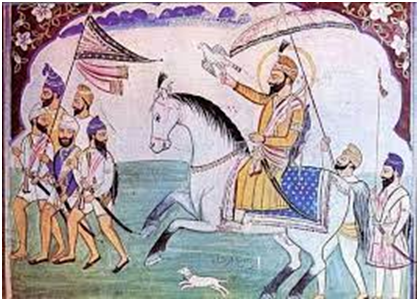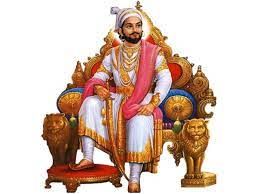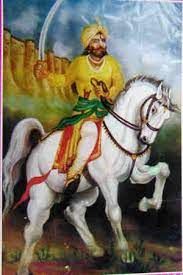- Books Name
- Social Science Book
- Publication
- Cognizance Publication
- Course
- CBSE Class 7
- Subject
- Social Science
Seizing independence
The sikhs
During the 17th century, sikhs built regional state Punjab. Several battles were fought by Guru Gobind Singh against the Rajput and Mughal rulers.Both before and after the institution of the Khalsa in 1699.After his death in 1708.The Khalsa rose in the world against the Mughal authority underBanda Bahadur’s leadership, declared their sovereign rule by striking coins in the name of Guru Nanak and Guru Gobind Singh and established their own administration between the Satluj and Jamuna.

Banda Bahadur was captured in 1715 and executed in 1716. Under the number of able leaders in the eighteenth century, the Sikhs organised themselves into a number of bands called jathas and later on misls.Their combined forces were known as the grand army(dal khalsa). The entire body used to meet at Amritsar at the time of Baisakhi and Diwali to take collective decisions known as “resolutions of the Guru gurmatas”.A system called rakhi was introduced, offering protection to cultivators on the payment of a tax of 20 per cent of the produce.The khalsa declared their sovereign rule by striking their own coin again in 1765.Significantly, the coin bore the same inscription as the one on the orders issued by Khalsa in the time of Banda Bahadur.The Sikh territories in the late eighteenth century extended from the Indus to the Jamuna, but they were divided under different rulers. One of them, Maharaja Ranjit Singh, reunited these groups and established his capital at Lahore in 1799.
The Marathas
Chhatrapati Shivaji
Towards the end of the 17th century, a powerful state started emerging in the Deccan under the leadership of Shivaji, which finally led to the establishment of the Maratha state. Shivaji was born to Shahji and Jija Bai at Shivneri in 1630.Under the guidance of his mother and his guardian, Dada Konddev ,Shivaji embarked on a career of conquest at a young age. The occupation of javli made him the undisputed leader of the mavalahighlands, which paved the way for further expansion.

His exploits against the forces of Bijapur and the Mughals made him the legendary figure. He often resorted to guerrilla warfare against his opponents.He carved out a stable Maratha Kingdom with the support of powerful warrior family (deshmukhs).Groups of highly mobile peasant-pastoralists(kunbis), provided the backbone of the Maratha army.Shivaji, used these forces to challenge the Mughals in the peninsular.After Shivaji’s death, effective power in the Maratha state was wielded by a family of Chitpavan Brahmanas who served Shivaji successor as Peshwa(or principal minister).
Poona became the capital of Maratha Kingdom.Between 1720 and 1761, the Maratha empire expanded.Malwa and Gujarat were seized from the Mughals by the 1720s.The Maratha king was recognised as the overload of entire Deccan peninsula by the 1730s. He possessed the right to levy a chauth and sardeshmukhi in the entire region. Alongside endless military campaigns, the Marathas developed an effective administrative system as well. Agriculture was encouraged and trade revived, this allowed Maratha chief,like Sindhia of Gwalior, Gaekwad of Baroda and Bhonsle of Nagpur the resources to raise powerful armies.Ujjain expanded under Sindhia’s patronage and Indore under Holkar’s.By all accounts, these cities were large and prosperous, and functioned as important commercial and cultural centres.New trade routes emerged within the areas controlled by the Marathas. The silk produced in the Chanderi region now found a new outlet in Poona, the Maratha capital.Burhanpur, which has earlier participated in the trade between Agra and Surat, now expanded its hinterland to include Pune, Nagpur in the South and Lucknow and Allahabad in the east.
Bajirao I, also known as Bajirao Ballal, was the son of Peshwa Balaji Vishwanath. He was a great Maratha general who is credited to have expanded the Maratha Kingdom beyond the vindhyas and is known for his military campaigns against Malwa, Bundelkhand, Gujarat and the Portuguese.
Chaut-.25 percent of the land revenue claimed by zamindars.In the Deccan this was collected by the Marathas.
Sardeshmukhi-9 to10 percent of the land revenue paid to the head revenue collector in the Deccan.
The Jats
The Jats consolidated their power during the late 17th and 18th centuries.Under their leader, Churaman, they acquired control over territories situated to the west of the city of Delhi. The Jats were prosperous agriculturist, and towns like Panipat and Ballabgarh became important trading centers in the areas dominated by them.Under Surajmal, the Kingdom of Bharatpur emerged as a strong state.When Nadir Shah sacked Delhi in 1739, many of the cities notables took refugee there. His son Jawahir Shah, as 30,000 troops of his own and hired another 20,000 Marathas and 15,000 Sikh troops to fight the Mughals.The Bharatpur Fort was built in a fairly traditional style, at Dig the Jats built an elaborate garden palace combining styles seen at Amber and Agra. Its buildings were modelled on architectural forms, first associated with royalty under Shah Jahan.

The power of the Jats reached its zenith under Surajmal, who consolidated the Jat state Bharatpur during 1756-1763. The areas under the political control of Surajmal broadly included part of modern eastern Rajasthan,southern Haryana, western Uttar Pradesh and Delhi.Surajmal built the number of forts and palaces and the famous Lohagad Fort in Bharatpur is regarded as one of the strongest forts built in this region.

 Cognizance Publication
Cognizance Publication
